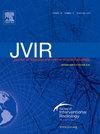Yttrium-90 Radiation Segmentectomy for Treatment of Neuroendocrine Liver Metastases
IF 2.6
3区 医学
Q2 PERIPHERAL VASCULAR DISEASE
Journal of Vascular and Interventional Radiology
Pub Date : 2025-02-01
DOI:10.1016/j.jvir.2024.11.003
引用次数: 0
Abstract
Purpose
To assess the safety and effectiveness of yttrium-90 (90Y) radiation segmentectomy (RS) for neuroendocrine tumor liver metastases (NELMs).
Materials and Methods
This single-institution retrospective study included 18 patients with 23 liver tumors not amenable to resection or ablation, who underwent RS between 2009 and 2021. Tumor grades by Ki-67/mitotic indices were Grade I (n = 9/23, 39%), Grade II (n = 10/23, 45%), and Grade III (n = 4/23, 17%). Eleven patients (61%) were previously treated with somatostatin analogs, 5 (28%) with chemotherapy, and 2 (11%) with peptide receptor radionuclide therapy. Safety was assessed with preprocedural/postprocedural liver chemistries, blood counts, and clinical adverse events (AEs) using National Cancer Institute Common Terminology Criteria for Adverse Events (CTCAE) version 5.0. Tumor response was assessed per Response Evaluation Criteria in Solid Tumors (RECIST) version 1.1 and modified RECIST (mRECIST) criteria. Kaplan-Meier analysis was used to estimate median overall survival (OS), progression-free survival (PFS), and time to progression (TTP) from the date of 90Y.
Results
Median follow-up was 31.9 months. Grade 1 fatigue was observed in 13 of 18 patients (72%), with 1 of 18 patients (6%) experiencing Grade 3 fatigue. Three patients (17%) exhibited Grade 3 lymphopenia. No other Grade 3 or any Grade 4 AE was observed. Tumor objective response was achieved in 83% of patients by RECIST size criteria and 100% by mRECIST enhancement criteria. Median OS was 69.4 months (95% CI, 23.1–99.4), and median PFS was 12.2 months (95% CI, 4.6–28.8). Median overall TTP was 13.0 months (95% CI, 4.6–45.1), with median treated tumor TTP not reached.
Conclusions
90Y RS demonstrated high rates of antitumor response with a favorable toxicity profile and durable OS in the treatment of NELMs.

用于治疗神经内分泌肝转移瘤的烧蚀剂量Y90放射分段切除术
目的:评估Y90放射分段切除术(RS)治疗神经内分泌肿瘤肝转移瘤(NELMs)的安全性和有效性:这项单一机构的回顾性研究纳入了 2009 年至 2021 年间接受 RS 治疗的 18 位患者,他们患有 23 个无法切除或消融的肝脏肿瘤。根据Ki-67/有丝分裂指数,肿瘤分级为I级(9/23,39%)、II级(10/23,45%)和III级(4/23,17%)。11名患者(61%)曾接受过体生长抑素类似物治疗,5名患者(28%)接受过化疗,2名患者(11%)接受过肽受体放射性核素治疗。安全性评估包括肝脏前后化学检查、血细胞计数以及采用美国国家癌症研究所AEs通用术语标准v5.0的临床不良事件(AEs)。肿瘤反应根据实体瘤反应评估标准 1.1 和修改后的 RECIST 标准进行评估。采用卡普兰-梅耶尔分析法估算自Y90之日起的中位总生存期(OS)、无进展生存期(PFS)和进展时间(TTP):中位随访时间为 31.9 个月。13/18例患者(72%)出现1级疲劳,1/18例患者(6%)出现3级疲劳。3名患者(17%)出现3级淋巴细胞减少症。没有观察到其他 3 级或任何 4 级 AE。根据 RECIST 肿瘤大小标准,83% 的患者获得了肿瘤客观反应;根据 mRECIST 增强标准,100% 的患者获得了肿瘤客观反应。中位OS为69.4个月(95% CI,23.1-99.4),中位PFS为12.2个月(95% CI,4.6-28.8)。中位总体TTP为13.0个月(95% CI,4.6-45.1),中位治疗肿瘤TTP未达到:结论:Y90 RS治疗NELM的抗肿瘤反应率高,毒性反应小,OS持久。
本文章由计算机程序翻译,如有差异,请以英文原文为准。
求助全文
约1分钟内获得全文
求助全文
来源期刊
CiteScore
4.30
自引率
10.30%
发文量
942
审稿时长
90 days
期刊介绍:
JVIR, published continuously since 1990, is an international, monthly peer-reviewed interventional radiology journal. As the official journal of the Society of Interventional Radiology, JVIR is the peer-reviewed journal of choice for interventional radiologists, radiologists, cardiologists, vascular surgeons, neurosurgeons, and other clinicians who seek current and reliable information on every aspect of vascular and interventional radiology. Each issue of JVIR covers critical and cutting-edge medical minimally invasive, clinical, basic research, radiological, pathological, and socioeconomic issues of importance to the field.

 求助内容:
求助内容: 应助结果提醒方式:
应助结果提醒方式:


